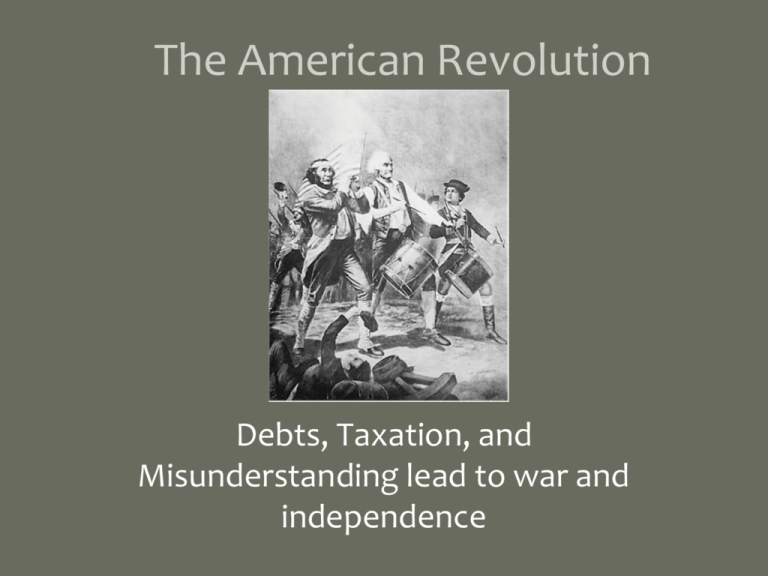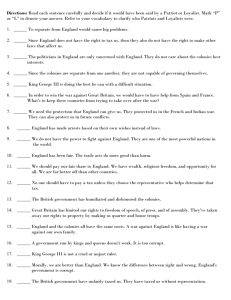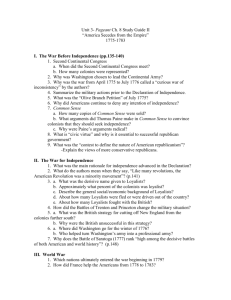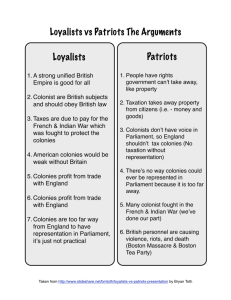The Causes of the American Revolution1
advertisement

The American Revolution Debts, Taxation, and Misunderstanding lead to war and independence American Heroes: 1763 Victory and the treaty of Paris meant? • Peace? An end to French intrusion in the colonies. • Prosperity in commerce with England/ • Protestant unity Consequences • Pontiacs Rebellion (see 500 Nations) • Washington becomes a hero • Indians lose big in the treaty…they are not included in the treaty, resolved a bit by the Proclamation of 1763, but the encroachment of their lands will continue. Consequences • Proclamation of 1763 Consequences • France loses all claims to lands East of the Mississippi, gives land West of the Mississippi to the Spanish for their contributions to the war. Impact of Pontiac’s Rebellion • The incredible assault by the Odawa illustrated that the British had to keep an army in North America. War Debts • Britain accumulated 130,000,000 in war debts. • An annual budget of 250,000 to maintain a military presence in colonies. The Sugar Act • Lowered the tax (duty) on sugar by ½. • Colonial tax burden? 1:26 • Set up special courts for smugglers. • Response? Led by Samuel Adams—non importation. The Stamp Act • Nature of discontent? • The Law? Virtual Representation • “the right of exemption from all taxes without their consent…would deprive them of every privilege distinguishing freemen from slaves. The Protest • Stamp Act Congres • Harassment: Andrew Oliver and Thomas Hutchinson • Key components of protest: restating of civil rights and nonimportation. The Virginia Resolves • The resolves claimed that Virginia was an independent realm of the British Crown, subject to taxation only by its colonial assembly and not by Parliament. “The Repeal” The Declaratory Act • The Declaratory Act asserted Britain's exclusive right to legislate for and tax its colonies External v. Internal Taxes • Colonists tended not to mind “external taxes” such as the Molasses Act. • These were meant to regulate trade. • Internal or “direct” taxes were much more contemptible to the colonists. They were designed not to regulate trade, but to raise revenue. Townshend Acts: 1768 • Revenue Act: a duty placed on items such as tea, lead, paper, and barrels. • Townshend’s view on taxes • Taxation and the salary of governors…a key component. • NY Suspending Act Response to the Townshend Acts • Daughters of Liberty (Daughters of the American Revolution) • Samuel Adams Circular Letter • Non-Importation (40% dip in already strained British commerce) • Townshend Acts Repealed. John Dickinson • Letters from a farmer in Pennsylvania • “an imposition on the subject for the sole purpose of levying money.” • Opposed to independence: • “torn from the body to which we are united…where shall we find another Britain to support us” 3/5/1770: Joy and Sorrow • The Townshend Acts Repealed • Boston Massacre • Ended a period of calm Eyewitness Account • "A number of persons, to the amount of thirty or forty, mostly boys and youngsters, who assembled ... near the sentry at the Custom-house door, damned him, and bid him fire and be damned; and some snow ball were throwed ... I saw a party of soldiers come from the main guard, and draw themselves up ... the people still continued in the street, crying, 'Fire, fire, and be damned,' and hove some more snow balls, whereupon I heard a musket go off, and in the space of two or three seconds, I heard the word 'fire' given ... and instantly the soldiers fired one after another." Tea Act of 1773 • Changes in the tea policy. • Dutch smuggling • Cheaper yet better tea! • Goal to sell 17,000,000 lbs of tea in the colonies at a discount. • Taxes within England were refunded at the expense of the colonies. • NO COLONIAL SALESMAN—all done by representatives of the British East India Company. Boston Tea Party: Response: The Coercive Acts • Boston Port Act: prohibited the loading or unloading of ships in the port of Boston after June 1 and until the town had paid for the tea. • Massachusetts Government Act: abolished the charter of 1691 and restored it to English control. • Administration of Justice Act: treasonous criminals tried in England not the colonies. • Quartering Act: permitted British troops to be quartered with towns throughout the entire colonies. Goal? • Divide the colonies and punish Massachusetts…crush any remnants of revolt. • Result: Colonies bound together. First Continental Congress • Coordinating event that saw 12/13 (Ga.) colonies meet in Philadelphia. Their powers were limited, but it was unified. • Boycott • Continental Association • Committees of Correspondence Goal of the 1st CC? • “We ask for only for peace, liberty, and security. We wish no diminution of royal prerogatives, we demand no new rights.” • Purpose: coordinate the colonists opposition to the Coercive Acts. • Any response such as non-importation would be conducted everywhere. • Sought reconciliation minus taxation. Suffolk Resolves • Delivered to the 1st CC by Paul Revere. • Encouraged people to not pay taxes, disobey the coercive acts, elect militia officials and train for war. Final Steps Towards War • Neither the King nor Parliament willing to back down. • When the colonists submitted their petition to address Parliament on grievances they voted no 218-68 • Referring to them as “unruly children” and “rude rabble” King George III • “The New England Governments are in rebellion, blows must decide whether they are to be subject to this country or independent”. King George III The Battles • Lexington and Concord-response to the British occupation of Boston (since 1768) – Gage’s goal was to remove ammunitions from local patriots. His wife foiled the plan by alerting the Patriots. Revere’s Ride • Colonists had been on high alert of a possible British plot, alarm and messenger systems were established were designed to alert leaders like Adams, and Hancock of any changes. The most famous was Revere’s Ride. The Casualties… • Initially the British urged minutemen to disperse. Then a shot was fired, eight Patriots died in the ensuing battle. The British proceeded on to Concord to find the munitions. Finding nothing, they moved back to Boston…guerilla fighting having broken out along the entire route, killing 273 British. Slavery and the Rebellion • 1775 Lord Dunmore of Virginia offered amnesty to all slaves if they assisted the British in putting down the local rebellion. Bunker Hill • Bunker Hill: costly British Victory. Colonist gain confidence. • “it was a dear bought victory another would have ruined us.” • Chose not to pursue the Americans Dual Roles of the 2nd CC • Pursue Peace: Olive Branch Petition • Pursue War: Declaration of Independence, Cont. Army • This contradiction made this first government of this country most difficult. Perspectives • Most of the delegates who attended the Second Continental Congress were not yet prepared for a total break with England. • Most eager for independence were the Massachusetts men, whose colony had been stripped of civil government by the Coercive Acts. • Delegates from the middle and southern colonies were more inclined toward reconciliation, fearing that fighting for independence would disrupt trade, create civil unrest, and leave the colonies vulnerable to enemies like France and Spain. Thomas Paine • The most clear case for Independence came from Paine. Many Americans “wavered”. • Document sold 150,000 copies in a matter of weeks. Declaration of Independence • By early July spurred on by Paine’s appeal for common sense, calls were being made for Independence. By July only New York a loyalist hotbed remained outside the other colonies. Tale of the Tape: Americans • The American forces had the advantage of being highly motivated to fight and theoretically could mobilize considerable manpower. Cause, patriotism… • However, Americans traditionally had relied on militia, which were good for limited engagements but not for long wars requiring military campaigns far from home Role of Women? • Over the course of the war, some 231,000 men spent time in military service, amounting to roughly one-quarter of the white male population over age sixteen. Close to 20,000 women served in the Continental army as cooks, washerwomen, and nurses. Key Battles • British retreated from Boston in 1776 taking the fight to the Middle States. • Defeat in New York: Washington suffers defeat by the Howe brothers as he is outnumbered and late arriving. Victories come slowly • On December 26th, Washington's Army crossed the Delaware and surprised the British at Trenton. The main attack was made by 2,400 troops under Washington on the Hessian Garrison. • Washington's troops achieved total surprise and defeated the British forces. The American victory was the first of the war, and helped to restore American morale. Victory at Princeton • Gen. Howe responded to the fall of Trenton by sending 5,550 troops south from New York through Princeton toward Trenton.. Cornwalis found Gen. Washington's troops along the ridge of the Assunpink Creek, and decided to wait until the next day to attack. Overnight, Washington moved his troops out of Trenton and into Princeton to the north. A desperate fight ensued in Princeton, in which the Americans almost lost. • Washington's timely arrival on horseback, however, served to rally the Americans, and the Colonial army defeated Mawhood's troops, forcing them to retreat to Trenton Defeat in Philadelphia • Washington suffers staggering losses (15,000 down to 6,000 through death and dessertion). • Brandywine Creek • Huge loss for the colonists. • The Continental Congress forced to flee (first of several flees). Victory at Saratoga Turning Point • The surrender at Saratoga dramatically changed Britain's war strategy. From that time on, the British generally kept their troops along the coast, close to the big guns and supply bases of the British fleet • France enters war against Britain after this huge victory. Valley Forge • During the winter after Saratoga (1777-78), spirits ran high, but finances and supplies ran perilously low. Washington's army at Valley Forge witnessed some of the worst privations of the entire war due to corrupt suppliers and greedy farmers, who preferred to sell grain to the British—who could pay in hard currency—rather than to their own army. Foreigners lend a hand • Friedrich von Steuben • Marquis de Lafayette A Revolution of equality? • Women served in the army • Blacks served to the tune of 5,000 in the north. • Commoners, merchants, and wealthy participated. • The American dream of equality had been born. Real American Strategy? • Keep the British in long enough to promote unrest and discontent with the economics at home…they’ll eventually leave. • Sound familiar? The British Strategy • Britain's objective was not so straightforward: to restore loyalist regimes to power in the colonies while not destroying the enemy completely. • Counting on substantial pockets of loyalist support in the Carolinas and the middle colonies, the British assumed this goal would not be too difficult to achieve. They initially focused their military campaigns on New York, Pennsylvania, and New Jersey. • Strategically, the overall British plan was to divide and conquer—to separate the rebellious colonies from those believed to be still loyal. The War at Home: Patriots and Loyalists • Between 20 and 30 percent of the American population remained loyal to the British monarchy in 1776. Their motivations varied. Some were royal officeholders; others were merchants whose businesses were linked to the imperial system; still others were cultural, ethnic (most notably Native Americans and African slaves), and religious groups that had no reason to believe they would fare better under an independent American government than they had under the British. Loyalist strongholds thus could be found everywhere, although the largest pockets were in the middle colonies and in the South. The Plight of Loyalists • Who Is a Traitor? In June 1775, the First Continental Congress passed a resolution declaring loyalists to be traitors. • Over the course of the war, hounded by patriots in their communities and harassed by legislative and judicial actions, many loyalists found their position intolerable. Thousands of loyalists eventually fled the country, seeking sanctuary in England or Canada. Paying for the war? • One of the nation's biggest problems was finding ways to finance the war. • The Continental Congress printed money, but its value fell rapidly. • One way to pay for the war was through borrowing hard money from wealthy men, who were given certificates of debt in return. • Congress also resorted to paying soldiers with promises of land. • In vain, the congress tried to stem the inflationary spiral by instituting price controls. Southern Strategy • The British shifted their efforts to the south for a number of reasons. • Loyalist sentiment was considered to be strongest in the southern colonies, and planters' nervousness about the war's impact on trade and their slave populations meant that they might be more amenable to coming over to the British side. • British suffered key losses such as at Cowpens. Yorktown • In 1781, the British general Cornwallis moved into North Carolina, hoping to prevent the colony from providing patriot guerrillas in South Carolina with arms and men. Although he was not successful, he decided to move into Virginia, capturing Williamsburg and Charlottesville and ultimately making his way to Yorktown. The fortunes of war turned in the rebels' favor with the arrival of the French navy. While French ships sealed off any retreat by sea, Washington surrounded Cornwallis on land. After a short siege, Cornwallis surrendered on October 19, 1781. Winners and Losers • Although the surrender at Yorktown marked the official end of the war, it would be two more years before a peace treaty was signed. It took time for both sides to acknowledge that the end finally had arrived, and neither wanted to withdraw from the field until the other side had as well. Results American Gains Losers • The American diplomats Benjamin Franklin, John Adams, and John Jay, who negotiated the peace treaty, secured favorable terms: official recognition of American independence and of the United States and transfer of all territory east of the Mississippi River, between Canada and Florida, to the new nation. • Native Americans and their effort goes unrecognized. Their lands are now up for siege by the colonists. • Britain lost their colonial holdings in North America (not Canada) •With the treaty finally signed, the British began their evacuation of New York—in New York City, more than 27,000 soldiers and 30,000 loyalists sailed on hundreds of ships for England in late fall 1783. Why England Lost? • Many factors contributed to the British defeat. It was hard for the British to supply their army, especially since they did not want to ravage the countryside. • At the same time, the British failed to back the loyalists and use their energies effectively. • The French alliance and military support throughout were crucial to the American victory. Finally, after abdicating civil power in the colonies in 1775 and 1776, the British were never able to regain it.




